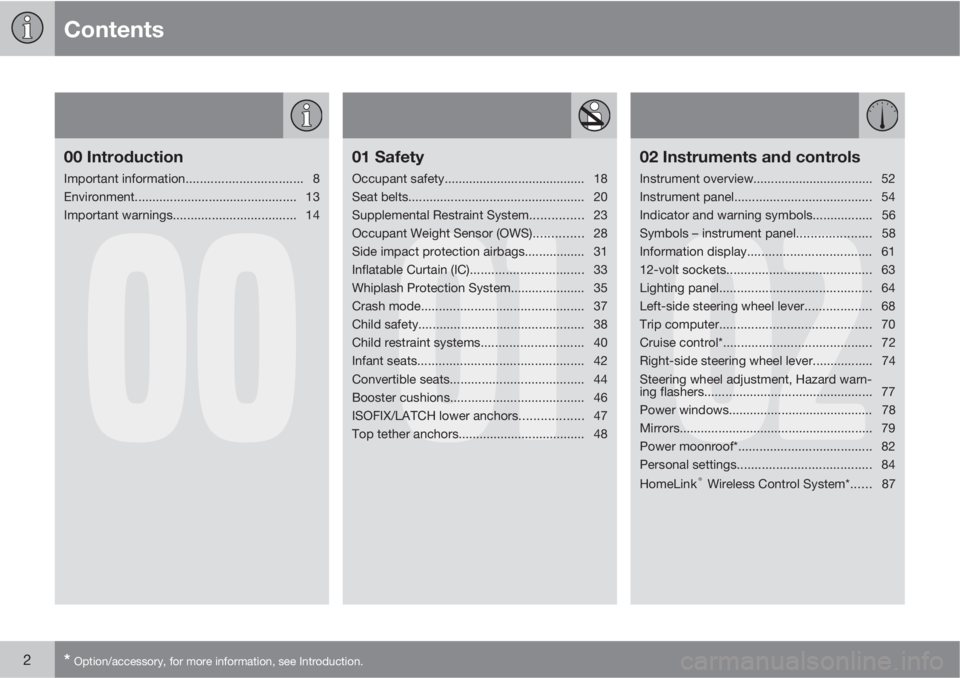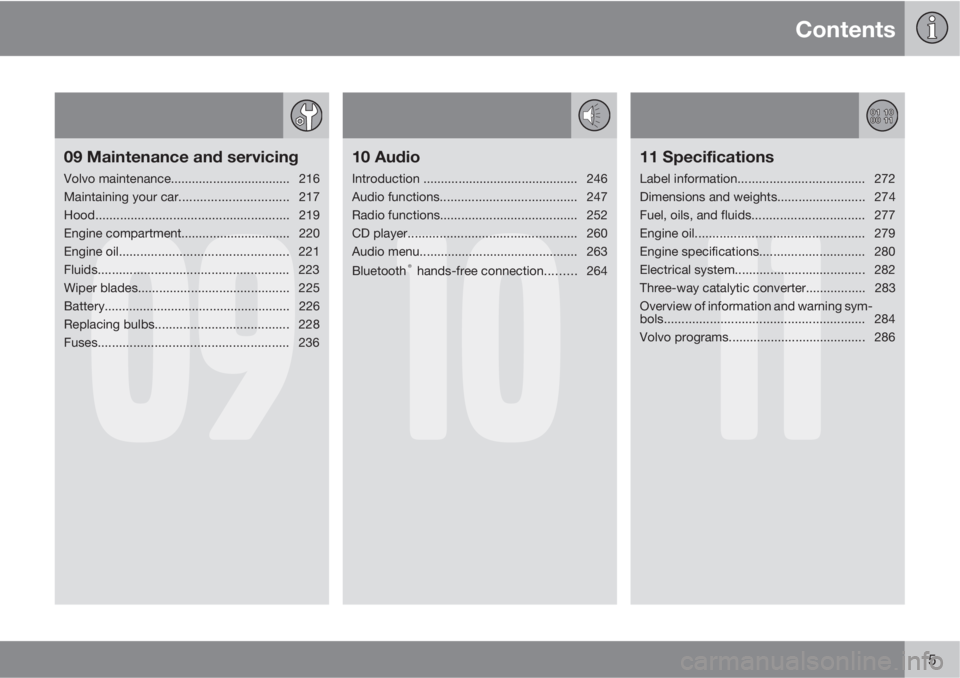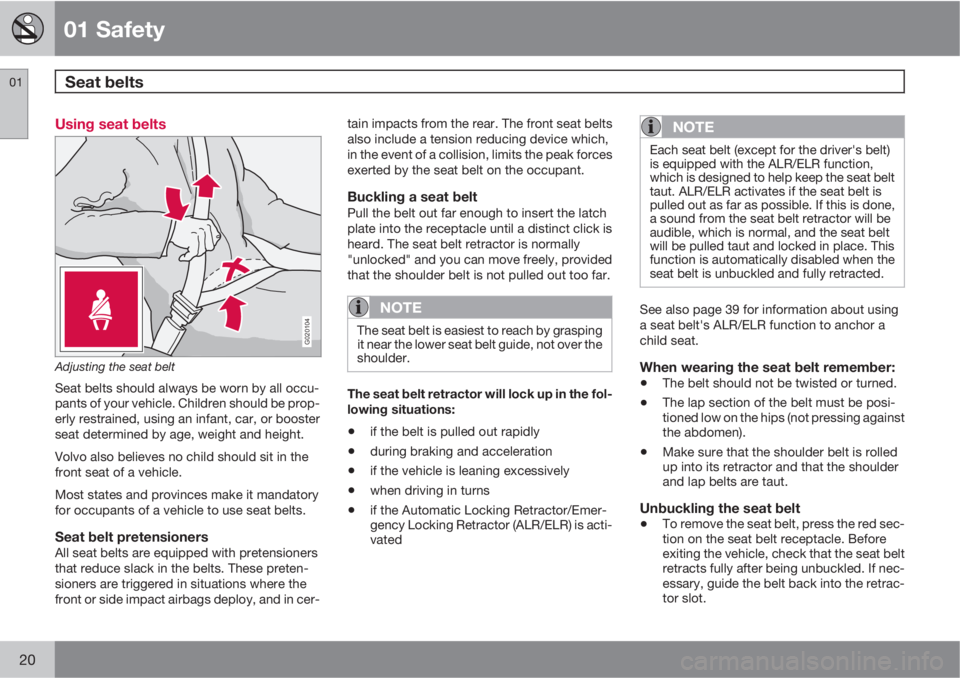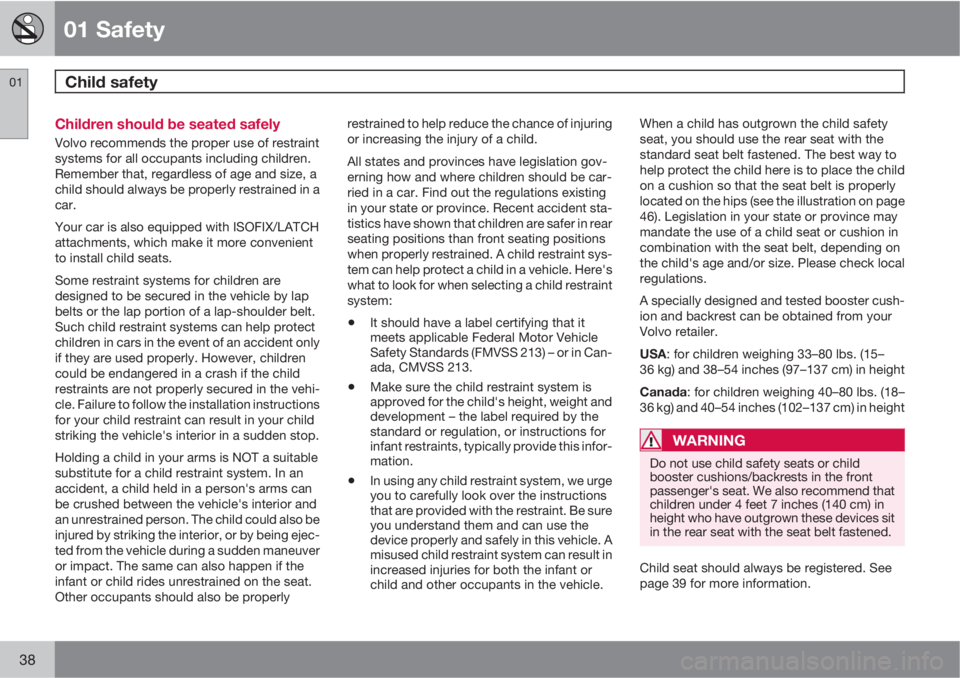weight VOLVO C30 2013 Owner´s Manual
[x] Cancel search | Manufacturer: VOLVO, Model Year: 2013, Model line: C30, Model: VOLVO C30 2013Pages: 300, PDF Size: 6.58 MB
Page 4 of 300

Contents
2* Option/accessory, for more information, see Introduction.
00
00 Introduction
Important information................................. 8
Environment.............................................. 13
Important warnings................................... 14
01
01 Safety
Occupant safety........................................ 18
Seat belts.................................................. 20
Supplemental Restraint System............... 23
Occupant Weight Sensor (OWS).............. 28
Side impact protection airbags................. 31
Inflatable Curtain (IC)................................ 33
Whiplash Protection System..................... 35
Crash mode.............................................. 37
Child safety............................................... 38
Child restraint systems............................. 40
Infant seats............................................... 42
Convertible seats...................................... 44
Booster cushions...................................... 46
ISOFIX/LATCH lower anchors.................. 47
Top tether anchors.................................... 48
02
02 Instruments and controls
Instrument overview.................................. 52
Instrument panel....................................... 54
Indicator and warning symbols.................56
Symbols – instrument panel..................... 58
Information display................................... 61
12-volt sockets......................................... 63
Lighting panel........................................... 64
Left-side steering wheel lever................... 68
Trip computer........................................... 70
Cruise control*.......................................... 72
Right-side steering wheel lever................. 74
Steering wheel adjustment, Hazard warn-
ing flashers................................................ 77
Power windows......................................... 78
Mirrors....................................................... 79
Power moonroof*...................................... 82
Personal settings...................................... 84
HomeLink
® Wireless Control System*...... 87
Page 7 of 300

Contents
5
09
09 Maintenance and servicing
Volvo maintenance.................................. 216
Maintaining your car............................... 217
Hood.......................................................219
Engine compartment............................... 220
Engine oil................................................ 221
Fluids...................................................... 223
Wiper blades........................................... 225
Battery..................................................... 226
Replacing bulbs...................................... 228
Fuses...................................................... 236
10
10 Audio
Introduction ............................................ 246
Audio functions....................................... 247
Radio functions....................................... 252
CD player................................................ 260
Audio menu............................................. 263
Bluetooth
® hands-free connection......... 264
11
11 Specifications
Label information.................................... 272
Dimensions and weights......................... 274
Fuel, oils, and fluids................................ 277
Engine oil................................................ 279
Engine specifications.............................. 280
Electrical system..................................... 282
Three-way catalytic converter................. 283
Overview of information and warning sym-
bols......................................................... 284
Volvo programs....................................... 286
Page 18 of 300

16
Occupant safety...................................................................................... 18
Seat belts................................................................................................ 20
Supplemental Restraint System.............................................................. 23
Occupant Weight Sensor (OWS)............................................................. 28
Side impact protection airbags............................................................... 31
Inflatable Curtain (IC).............................................................................. 33
Whiplash Protection System................................................................... 35
Crash mode............................................................................................ 37
Child safety............................................................................................. 38
Child restraint systems........................................................................... 40
Infant seats.............................................................................................. 42
Convertible seats.................................................................................... 44
Booster cushions.................................................................................... 46
ISOFIX/LATCH lower anchors................................................................. 47
Top tether anchors.................................................................................. 48
Page 22 of 300

01 Safety
Seat belts 01
20
Using seat belts
G020104
Adjusting the seat belt
Seat belts should always be worn by all occu-
pants of your vehicle. Children should be prop-
erly restrained, using an infant, car, or booster
seat determined by age, weight and height.
Volvo also believes no child should sit in the
front seat of a vehicle.
Most states and provinces make it mandatory
for occupants of a vehicle to use seat belts.
Seat belt pretensionersAll seat belts are equipped with pretensioners
that reduce slack in the belts. These preten-
sioners are triggered in situations where the
front or side impact airbags deploy, and in cer-tain impacts from the rear. The front seat belts
also include a tension reducing device which,
in the event of a collision, limits the peak forces
exerted by the seat belt on the occupant.
Buckling a seat beltPull the belt out far enough to insert the latch
plate into the receptacle until a distinct click is
heard. The seat belt retractor is normally
"unlocked" and you can move freely, provided
that the shoulder belt is not pulled out too far.
NOTE
The seat belt is easiest to reach by grasping
it near the lower seat belt guide, not over the
shoulder.
The seat belt retractor will lock up in the fol-
lowing situations:
•if the belt is pulled out rapidly
•during braking and acceleration
•if the vehicle is leaning excessively
•when driving in turns
•if the Automatic Locking Retractor/Emer-
gency Locking Retractor (ALR/ELR) is acti-
vated
NOTE
Each seat belt (except for the driver's belt)
is equipped with the ALR/ELR function,
which is designed to help keep the seat belt
taut. ALR/ELR activates if the seat belt is
pulled out as far as possible. If this is done,
a sound from the seat belt retractor will be
audible, which is normal, and the seat belt
will be pulled taut and locked in place. This
function is automatically disabled when the
seat belt is unbuckled and fully retracted.
See also page 39 for information about using
a seat belt's ALR/ELR function to anchor a
child seat.
When wearing the seat belt remember:
•The belt should not be twisted or turned.
•The lap section of the belt must be posi-
tioned low on the hips (not pressing against
the abdomen).
•Make sure that the shoulder belt is rolled
up into its retractor and that the shoulder
and lap belts are taut.
Unbuckling the seat belt
•To remove the seat belt, press the red sec-
tion on the seat belt receptacle. Before
exiting the vehicle, check that the seat belt
retracts fully after being unbuckled. If nec-
essary, guide the belt back into the retrac-
tor slot.
Page 25 of 300

01 Safety
Supplemental Restraint System01
23 Supplemental Restraint System (SRS)
G026330
SRS warning light
As an enhancement to the three-point seat
belts, your Volvo is equipped with a Supple-
mental Restraint System (SRS). Volvo's SRS
consists of seat belt pretensioners, front air-
bags, side impact airbags, the occupant
weight sensor, and inflatable curtains. All of
these systems are monitored by the SRS con-
trol module. An SRS warning light in the instru-
ment panel (see the illustration) illuminates
when the ignition key is turned to position I, II,
or III, and will normally go out after approxi-
mately 7 seconds if no faults are detected in
the system.Where applicable, a text message will also be
displayed when the SRS warning light illumi-
nates. If this warning symbol is not functioning
properly, the general warning symbol illumi-
nates and either
SRS AIRBAG SERVICE
URGENT or SRS AIRBAG SERVICE
REQUIREDwill be displayed.
WARNING
•If the SRS warning light stays on after
the engine has started or if it illuminates
while you are driving, have the vehicle
inspected by a trained and qualified
Volvo service technician as soon as
possible.
•Never try to repair any component or
part of the SRS yourself. Any interfer-
ence in the system could cause mal-
function and serious injury. All work on
these systems should be performed by
a trained and qualified Volvo service
technician.
WARNING
If your vehicle has been subjected to flood
conditions (e.g. soaked carpeting/standing
water on the floor of the vehicle) or if your
vehicle has become flood-damaged in any
way, do not attempt to start the vehicle or
put the key in the ignition before discon-
necting the battery (see below). This may
cause airbag deployment which could result
in personal injury. Have the vehicle towed to
a trained and qualified Volvo service tech-
nician for repairs.
Automatic transmission
Before attempting to tow the vehicle, use
the following procedure to override the
shiftlock system to move the gear selector
to the neutral position:
1. Switch off the ignition for at least
10 minutes and disconnect the battery.
2. Wait at least one minute.
3. Insert the key in the ignition and turn it
to position II.
4. Press firmly on the brake pedal.
5.
Move the gear selector from Park (P) to
the Neutral (N) position, see page 158,
for information on manually overriding
the shiftlock system.
Page 28 of 300

01 Safety
Supplemental Restraint System 01
26
WARNING
•Do not use child safety seats or child
booster cushions/backrests in the front
passenger's seat. We also recommend
that occupants under 4 feet 7 inches
(140 cm) in height who have outgrown
these devices sit in the rear seat with the
seat belt fastened
1.
•Never drive with the airbags deployed.
The fact that they hang out can impair
the steering of your vehicle. Other
safety systems can also be damaged.
•The smoke and dust formed when the
airbags are deployed can cause skin
and eye irritation in the event of pro-
longed exposure.
Passenger's side airbag decal
G032934
Airbag decal on the outside of both sun visors
1See also the Occupant Weight Sensor information on page 28.
Page 30 of 300

01 Safety
Occupant Weight Sensor (OWS) 01
28
Disabling the passenger's side front
airbag
2
G018082
Occupant Weight Sensor (OWS) indicator light
Volvo recommends that ALL occupants (adults
and children) shorter than 4 feet 7 inches
(140 cm) be seated in the rear seat of any vehi-
cle with a passenger's side front airbag, and be
properly restrained. Children should always be
seated in child restraints appropriate for their
size and weight. See also the child safety rec-
ommendations on page 38.
The Occupant Weight Sensor (OWS) is
designed to meet the regulatory requirements
of Federal Motor Vehicle Safety Standard
(FMVSS) 208 and is designed to disable (willnot inflate) the passenger's side front airbag
under certain conditions.
The OWS works with sensors that are part of
the front passenger's seat and seat belt. The
sensors are designed to detect the presence of
a properly seated occupant and determine if
the passenger's side front airbag should be
enabled (may inflate) or disabled (will not
inflate).
The OWS will disable (will not inflate) the pas-
senger's side front airbag when:
•the front passenger's seat is unoccupied,
or has small/medium objects in the front
seat,
•the system determines that an infant is
present in a rear-facing infant seat that is
installed according to the manufacturer's
instructions,
•the system determines that a small child is
present in a forward-facing child restraint
that is installed according to the manufac-
turer's instructions,
•the system determines that a small child is
present in a booster seat,
•a front passenger takes his/her weight off
of the seat for a period of time,
•a child or a small person occupies the front
passenger's seat.The OWS uses a PASSENGER AIRBAG OFF
indicator lamp which will illuminate and stay on
to remind you that the passenger's side front
airbag is disabled. The PASSENGER AIRBAG
OFF indicator lamp is located in the overhead
console, near the base of the rearview mirror.
NOTE
When the ignition is switched on, the OWS
indicator light will go on for up to 10 seconds
while the system performs a self-diagnostic
test.
However, if a fault is detected in the system:
•The OWS indicator light will stay on
•The SRS warning light (see page 23) will
come on and stay on
The message
PASS. AIRBAG OFF SERVICE
URGENT will be displayed in the information
display.
Page 31 of 300

01 Safety
Occupant Weight Sensor (OWS)01
29
WARNING
If a fault in the system is detected and indi-
cated as explained on the preceding page,
be aware that the passenger's side front air-
bag will not deploy in the event of a collision.
In this case, the SRS system and Occupant
Weight Sensor should be inspected by a
trained and qualified Volvo service techni-
cian as soon as possible.
WARNING
•Never try to open, remove, or repair any
components in the OWS system. This
could result in system malfunction.
Maintenance or repairs should only be
carried out by an a trained and qualified
Volvo service technician.
•The front passenger's seat should not
be modified in any way. This could
reduce pressure on the seat cushion,
which might interfere with the OWS sys-
tem's function.
The OWS is designed to disable (will not inflate)
the passenger's side front airbag when a rear
facing infant seat, a forward-facing child
restraint, or a booster seat is detected. The
PASSENGER AIRBAG OFF indicator lamp will
illuminate and stay on to remind you that thepassenger's side front airbag is disabled (see
the following table).
Passenger's
seat occu-
pancy statusOWS indica-
tor light sta-
tusPassenger's
side front
airbag sta-
tus
Seat unoc-
cupiedOWS indica-
tor light
lights
up
Passenger's
side front
airbag disa-
bled
Seat occu-
pied by low
weight
occupant/
object
A
OWS indica-
tor light
lights
up
Passenger's
side front
airbag disa-
bled
Seat occu-
pied by
heavy occu-
pant/objectOWS indica-
tor light
is not
lit
Passenger's
side front
airbag ena-
bled
AVolvo recommends that children always be properly
restrained in appropriate child restraints in the rear seats. Do
not assume that the passenger's side front airbag is disabled
unless the PASSENGER AIRBAG OFF indicator lamp is lit.
Make sure the child restraint is properly installed. If there is
any doubt as to the status of the passenger's side front air-
bag, move the child restraint to the rear seat.
The OWS is designed to enable (may inflate)
the passenger's side front airbag in the event
of a collision anytime the system senses that aperson of adult size is sitting properly in the
front passenger's seat. The PASSENGER
AIRBAG OFF indicator lamp will be off and
remain off.
If a person of adult size is sitting in the front
passenger's seat, but the PASSENGER
AIRBAG OFF indicator lamp is on, it is possible
that the person isn't sitting properly in the seat.
If this happens:
1. Turn the vehicle off and ask the person to
place the seatback in an upright position.
2. Have the person sit upright in the seat,
centered on the seat cushion, with the per-
son's legs comfortably extended.
3. Restart the vehicle and have the person
remain in this position for about two
minutes. This will allow the system to
detect that person and enable the pas-
senger's frontal airbag.
4.
If the PASSENGER AIRBAG OFF indicator
lamp remains on even after this, the person
should be advised to ride in the rear seat.
This condition reflects limitations of the OWS
classification capability. It does not indicate
OWS malfunction.ModificationsIf you are considering modifying your vehicle in
any way to accommodate a disability, for
Page 32 of 300

01 Safety
Occupant Weight Sensor (OWS) 01
30
example by altering or adapting the driver's or
front passenger's seat(s) and/or airbag sys-
tems, please contact Volvo at:
In the USA
Volvo Cars of North America, LLC
Customer Care Center
1 Volvo Drive
P.O. Box 914
Rockleigh, New Jersey 07647
1-800-458-1552
In Canada
Volvo Cars of Canada Corp.
National Customer Service
175 Gordon Baker Road North York, Ontario
M2H 2N7
1-800-663-8255WARNING
•No objects that add to the total weight
on the seat should be placed on the
front passenger's seat. If a child is
seated in the front passenger's seat
with any additional weight, this extra
weight could cause the OWS system to
enable the airbag, which might cause it
to deploy in the event of a collision,
thereby injuring the child.
•The seat belt should never be wrapped
around an object on the front passeng-
er's seat. This could interfere with the
OWS system's function.
•The front passenger's seat belt should
never be used in a way that exerts more
pressure on the passenger than normal.
This could increase the pressure exer-
ted on the weight sensor by a child, and
could result in the airbag being enabled,
which might cause it to deploy in the
event of a collision, thereby injuring the
child.
WARNING
Keep the following points in mind with
respect to the OWS system. Failure to follow
these instructions could adversely affect the
system's function and result in serious injury
to the occupant of the front passenger's
seat:
•The full weight of the front seat passen-
ger should always be on the seat cush-
ion. The passenger should never lift
him/herself off the seat cushion using
the armrest in the door or the center
console, by pressing the feet on the
floor, by sitting on the edge of the seat
cushion, or by pressing against the
backrest in a way that reduces pressure
on the seat cushion. This could cause
OWS to disable the passenger's side
front airbag.
•Do not place any type of object on the
front passenger's seat in such a way
that jamming, pressing, or squeezing
occurs between the object and the front
seat, other than as a direct result of the
correct use of the Automatic Locking
Retractor/Emergency Locking Retrac-
tor (ALR/ELR) seat belt, see page 39.
•No objects should be placed under the
front passenger's seat. This could inter-
fere with the OWS system's function.
Page 40 of 300

01 Safety
Child safety 01
38
Children should be seated safely
Volvo recommends the proper use of restraint
systems for all occupants including children.
Remember that, regardless of age and size, a
child should always be properly restrained in a
car.
Your car is also equipped with ISOFIX/LATCH
attachments, which make it more convenient
to install child seats.
Some restraint systems for children are
designed to be secured in the vehicle by lap
belts or the lap portion of a lap-shoulder belt.
Such child restraint systems can help protect
children in cars in the event of an accident only
if they are used properly. However, children
could be endangered in a crash if the child
restraints are not properly secured in the vehi-
cle. Failure to follow the installation instructions
for your child restraint can result in your child
striking the vehicle's interior in a sudden stop.
Holding a child in your arms is NOT a suitable
substitute for a child restraint system. In an
accident, a child held in a person's arms can
be crushed between the vehicle's interior and
an unrestrained person. The child could also be
injured by striking the interior, or by being ejec-
ted from the vehicle during a sudden maneuver
or impact. The same can also happen if the
infant or child rides unrestrained on the seat.
Other occupants should also be properlyrestrained to help reduce the chance of injuring
or increasing the injury of a child.
All states and provinces have legislation gov-
erning how and where children should be car-
ried in a car. Find out the regulations existing
in your state or province. Recent accident sta-
tistics have shown that children are safer in rear
seating positions than front seating positions
when properly restrained. A child restraint sys-
tem can help protect a child in a vehicle. Here's
what to look for when selecting a child restraint
system:
•It should have a label certifying that it
meets applicable Federal Motor Vehicle
Safety Standards (FMVSS 213) – or in Can-
ada, CMVSS 213.
•Make sure the child restraint system is
approved for the child's height, weight and
development – the label required by the
standard or regulation, or instructions for
infant restraints, typically provide this infor-
mation.
•In using any child restraint system, we urge
you to carefully look over the instructions
that are provided with the restraint. Be sure
you understand them and can use the
device properly and safely in this vehicle. A
misused child restraint system can result in
increased injuries for both the infant or
child and other occupants in the vehicle.When a child has outgrown the child safety
seat, you should use the rear seat with the
standard seat belt fastened. The best way to
help protect the child here is to place the child
on a cushion so that the seat belt is properly
located on the hips (see the illustration on page
46). Legislation in your state or province may
mandate the use of a child seat or cushion in
combination with the seat belt, depending on
the child's age and/or size. Please check local
regulations.
A specially designed and tested booster cush-
ion and backrest can be obtained from your
Volvo retailer.
USA: for children weighing 33–80 lbs. (15–
36 kg) and 38–54 inches (97–137 cm) in height
Canada: for children weighing 40–80 lbs. (18–
36 kg) and 40–54 inches (102–137 cm) in height
WARNING
Do not use child safety seats or child
booster cushions/backrests in the front
passenger's seat. We also recommend that
children under 4 feet 7 inches (140 cm) in
height who have outgrown these devices sit
in the rear seat with the seat belt fastened.
Child seat should always be registered. See
page 39 for more information.